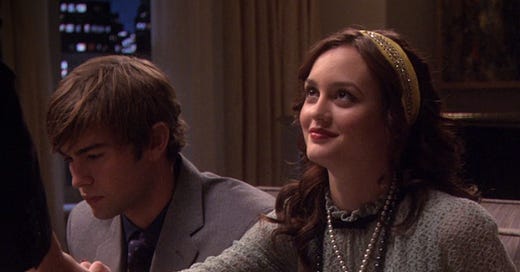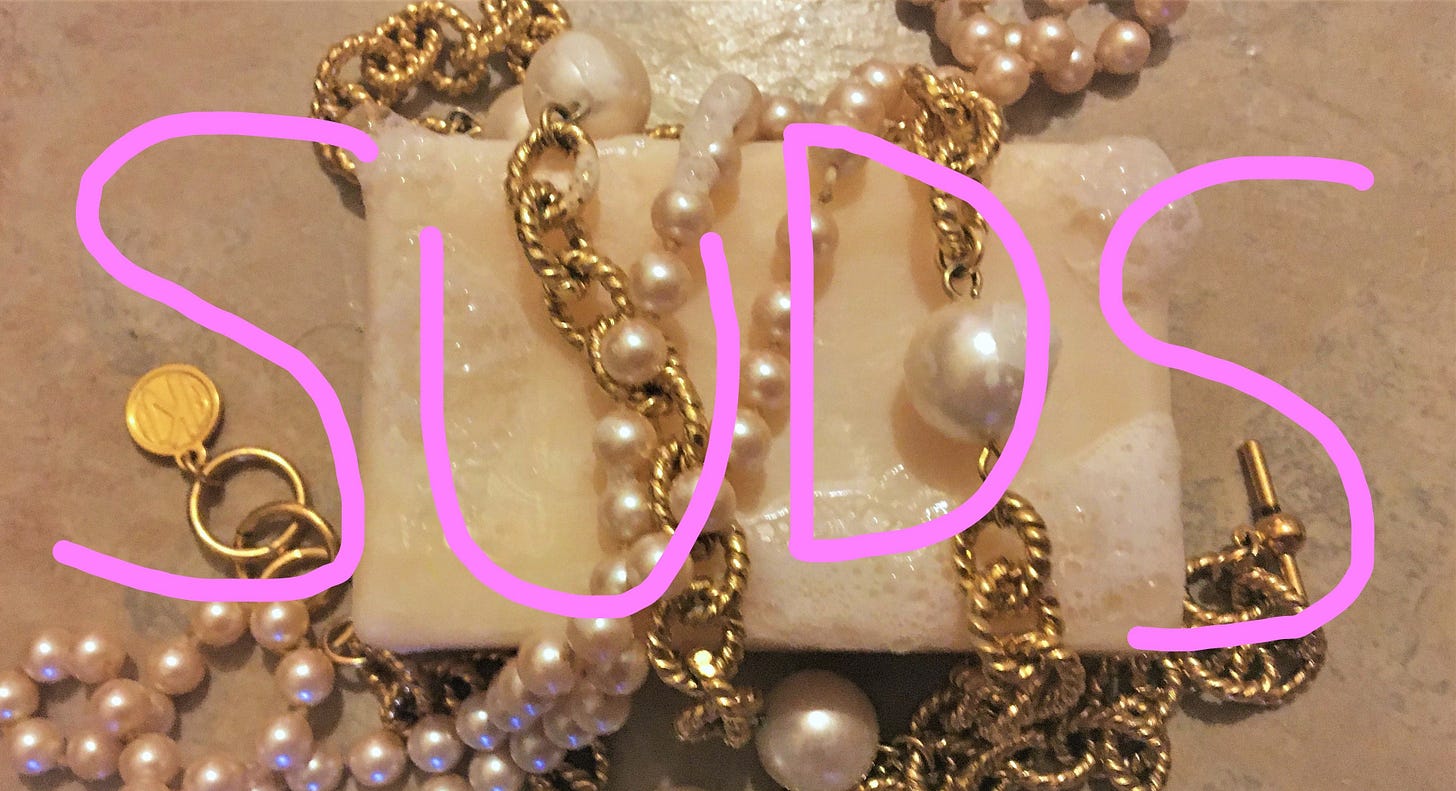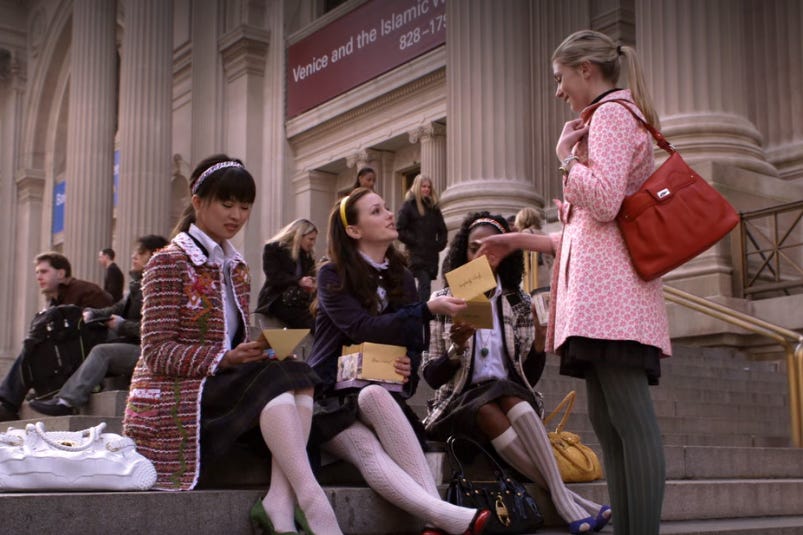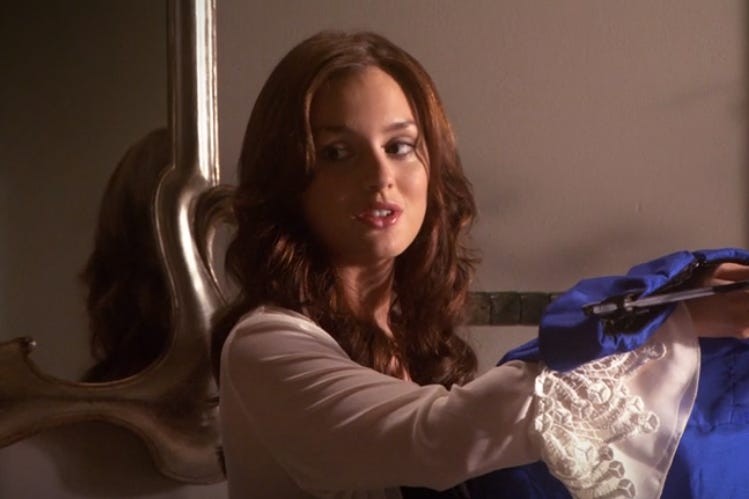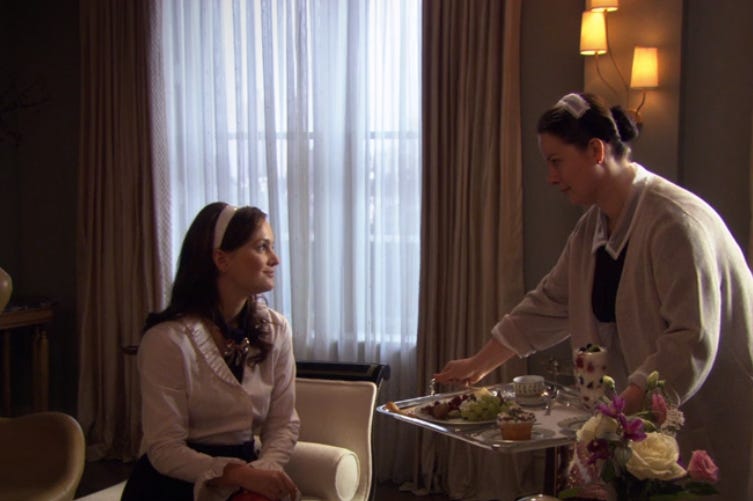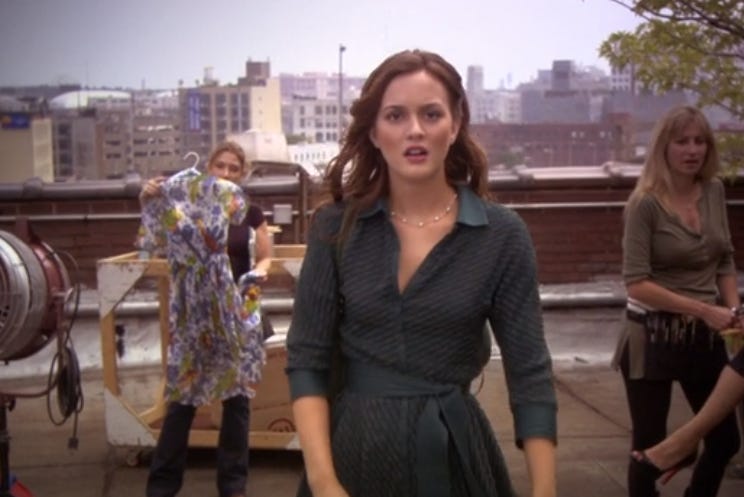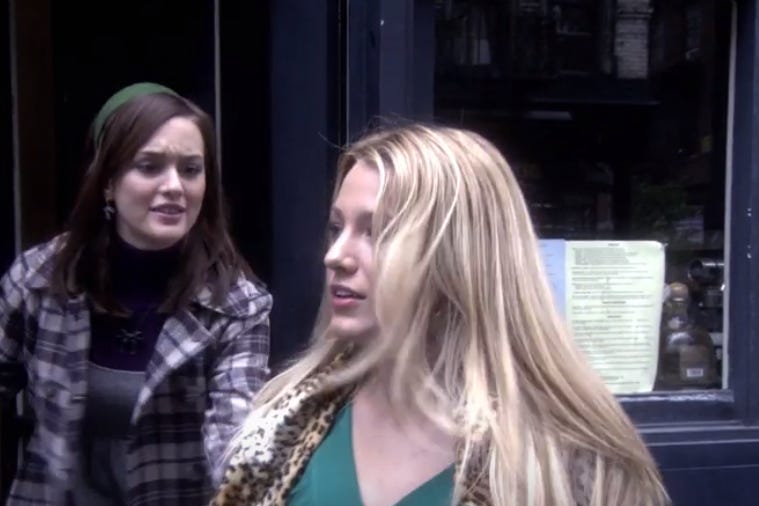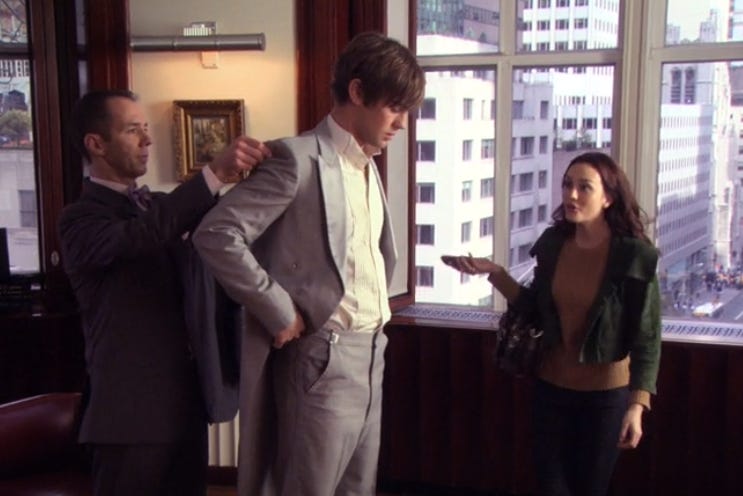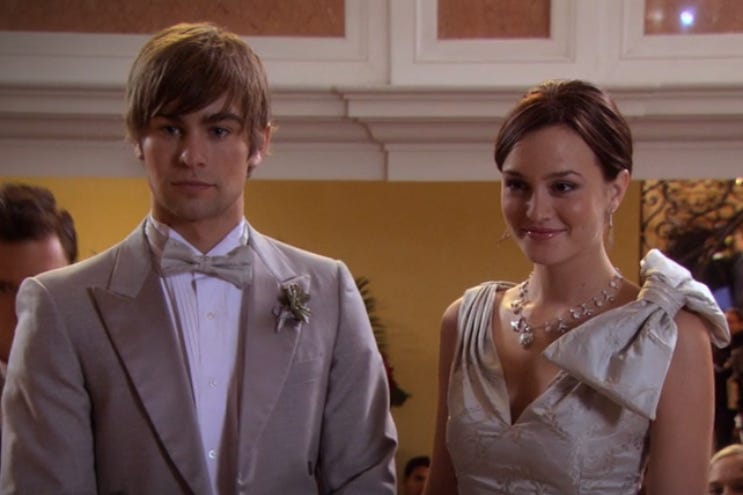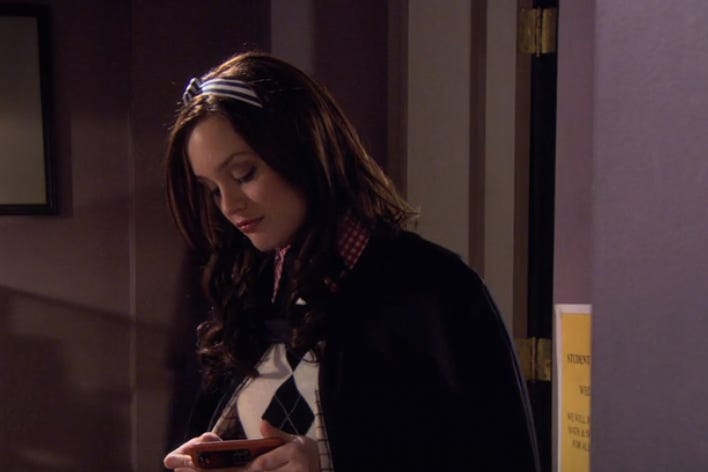[This profile contains discussion of eating disorders, abuse, and sexual assault.]
When I arranged the order of these profiles, I knew that Blair Waldorf’s would go last. She wouldn’t have it any other way. Not only is Blair the show’s most beloved character (type her name into YouTube and take in all the video compilations of her “best” or “most iconic” moments) but she’s also its most fashion conscious. The daughter of a designer, Blair speaks in fashion references and metaphors. “Fashion is the most powerful art there is,” she tells Dan Humphrey in season four. “It’s movement, design, and architecture all in one.”
Why is Blair so adored by viewers? I think the answer lies in her duality: she is both aspirational and relatable, perfect and flawed. She is rich, witty, beautiful, smart, thin; she has a bevy of handsome love interests. She is also deeply insecure, often jealous or scheming or cruel. She can be racist and classist and misogynist. (To quote one of the stars of the Gossip Girl reboot, Evan Mock: “Blair was a white girl boss who had these little minions, and they’re people of color, Asian” (Vanity Fair).)
Her central conflict—and certainly the focus of her costume design—is this war between her “good” or “light” or “sparkly” side and her “bad” or “dark” side. (Light-and-dark dualism is, of course, not unique to this show; many English metaphors enforce the racist idea of lightness or whiteness as good and darkness or blackness as bad.)
Blair’s “good” side is highly controlled: “a very meticulous, thought-out way of being,” as head costume designer Eric Daman puts it (Fashionista). She buttons her ruffled white blouses to the hilt, tops with them with tight bows and pearl necklaces and regal headbands or capes—all ways that she asserts her power and status. She is always “appropriate” (“Gossip Girl Couture”), dressed perfectly for the occasion, whether it be a brunch or a masked ball or a wedding. And yet, underneath, in private, she favors sheer robes and slips and lingerie sets; for Blair, her “bad” side always means her sexuality—a loss of control. Throughout the series, Blair tries to reconcile these two parts to create a better, whole self—and no surprise, fashion always plays an important role.
Season One
We first see Blair in a black dress with long lace sleeves and a black bow headband, black stockings and garters, and jet earrings. She’s at a party at the Waldorf penthouse, and she’s just learned that her best friend, Serena van der Woodsen, is back in the city.
The dress, we soon discover, is an Eleanor Waldorf original: “Tell me if you’re going to wear one of my designs,” Eleanor says to Blair, “so we can at least get it properly fitted.” This line is our first hint at the strained relationship between mother and daughter, and how that relationship fuels Blair’s insecurities, most especially about her body.
And yet, the black dress is a perfect first look at Blair; as I rewatched the series, I realized that Blair often chooses a black dress—usually paired with something sparkly, be it a necklace, neckline, or belt—for a formal occasion. The influence, I think, is her idol, Audrey Hepburn. After all, Audrey’s most iconic look is the black dress and sparkly accessories from the opening scene of Breakfast at Tiffany’s. For Blair, a black dress symbolizes style, elegance, grace, sophistication—everything Audrey embodies for her, everything she aspires to be.
Blair pulls her boyfriend, Nate Archibald, into her bedroom; she wants them to have sex for the first time before he finds out Serena is back. Sex, in Blair’s mind, is the only way to keep Nate from her more experienced friend; waiting for sex was once a form of control, and now not waiting is.
Nate overhears Serena’s arrival before he and Blair can have sex. The disappointed Blair must zip up her dress and fake an excited hello for Serena. She’s angry at her friend for going away to boarding school without telling her, for not being there during the Waldorfs’ messy divorce. The next day at school, Blair reluctantly agrees to a drink with Serena.
On the Met steps, where Blair and her minions reign, we get our first look at Blair’s uniform: a ruffled white blouse, navy blazer and crossover tie, white tights, and yellow headband, all with the junior class’s standard navy kilt. As queen of Constance Billard School for Girls, Blair favors preppy pieces with a regal air: the high-necked blouse like an Elizabethan ruff, the headband like a “crown” (“Couture”). Her minions, like a royal court, all copy elements of her look: headbands, white blouses, and white knee-high socks or stockings. The overall effect is one of unity and restraint, in contrast with the lone Serena; Blair and her minions never miss a button on their blouses, never unfasten their ties, but Serena wears her collar unbuttoned, her necktie loose, and with freshman year’s outgrown skirt.
That evening, Blair and Serena reconcile over martinis, then Blair leaves to finish what she started with Nate. In her bedroom, she surprises him in a pink baby-doll slip with black trim and black stockings—not unlike the ones she wore to the party. This is the other side of Blair Waldorf, the one under the buttoned-up blouses and ties, the one who wants to be sexual and sexy. Instead, Nate tells Blair why Serena ran away to boarding school: she and Nate slept together.
Blair is heartbroken, but she agrees to put the incident behind them after Nate promises never to see Serena. They’re going to attend the Kiss on the Lips party together, and Serena is not invited.
Eleanor has laid out a dress for her daughter, but Blair tries on this one instead: a silky purple gown with a sequined drop waist. It’s more sexy and formfitting than any outfit we’ve seen her in, and so Eleanor immediately rejects it: “This [dress] is not as elegant a choice as that one. Blair, you’ll never be more beautiful or thin or happy than you are right now.”
In her mother’s words, we hear many of Blair’s internalized ideas: that to be elegant is not to be sexy, that to be beautiful and thin is to be happy. It’s no surprise that Blair wears the other dress to the party, a black dress—paired with drop pearl earrings.
The next morning (1.2), Blair’s mother has left her a blue strapless Waldorf Designs dress, a note paper-clipped to it: “Went to Paris. [Bass] Brunch at 2. Wear pearls!” Blair discards the dress, giving it to an aspiring minion, Jenny Humphrey. “[The dress is] average,” she tells Jenny. “The color is last season. And besides, Stella McCartney has a much better version at Bergdorf’s.” Blair is incredibly knowledgeable about her mother’s high-fashion world, even if it’s at the expense of her mother’s own designs.
Serena visits before the brunch; she wants to pick up their Sunday morning tradition of watching Breakfast at Tiffany’s and eating croissants—a tradition likely invented by Blair. Blair rejects the plan, telling Serena that she knows she slept with Nate, that she always took Serena for a “slut” but not a “liar” too.
Naturally, Blair chooses virginal white for brunch: a white eyelet dress with a big bow at the waist, along with a navy bow headband, her signature ruby ring, and, what else, a little pearl bracelet. Though she may have tossed aside her mother’s dress, she can’t rebel completely.
After Blair finds Nate talking with Serena—as he promised he wouldn’t—her fury only increases: she tells Serena’s new love interest, Dan, why Serena ran away; she tells their school’s Ivy League mixer that Serena is being treated for addiction at the Ostroff Center (1.3).
Blair wants nothing more than to go to Yale, like her beloved father: “Do you remember when Dad gave me my first Yale sweatshirt?” she asks her maid and surrogate mother, Dorota (who, I should note, wears a headband as part of her uniform). “I don’t think any piece of clothing has ever fit me more perfectly.” In preparation for the mixer, the junior class attends an assembly, and Blair is pressed and coordinated, as usual: a white ruffled blouse, white headband, and red tights with her uniform skirt. And as if one bow isn’t enough, her crossover tie has a bow brooch pinned on top. Bows are already a motif for Blair—feminine, preppy, but also controlled, never undone, much like Blair herself. Even her clothing hangers are festooned with little bows.
To the mixer itself, Blair wears a navy suit, a yellow blouse with a brooch at the collar, and a pearl necklace; her hair in a bun. Her look is the most serious, least fashionable, that we’ve seen yet: closer in style to the Ivy League recruiters than her fellow students. The more Blair grasps at control—at securing admission to Yale, at defeating Serena—the more severe, conservative, her wardrobe gets.
After Blair learns that Serena is not a patient at the center—her brother, Eric van der Woodsen, is—she and Serena make up. Still, even in friendship, the threat of Serena—her beauty, her charisma, her ease—lurks. In episode four, we see our first Blair dream sequence, one of many throughout the series. Blair dreams in Hollywood movies, often taking the place of her favorite star, Audrey Hepburn.
In this dream, Blair is Holly Golightly in the opening scene of Tiffany’s: a black dress and opera gloves, piles of pearl necklaces and bracelets, a little crown, and black sunglasses. Blair approaches the store window, only to see it’s Henri Bendel’s, not Tiffany’s, and Serena is inside, Blair’s minions serving her. Dream Serena is wearing the same outfit Blair wore when Serena returned to the city: a black headband and black lace dress. In Blair’s mind, Serena is replacing Blair in her mother’s affections, all while wearing the dress that Eleanor said didn’t fit Blair properly.
Blair wakes to find her mother and Serena eating breakfast. Bendel’s, says Eleanor, is interested in carrying Waldorf Designs. Blair reaches for a croissant, the same pastry she carried in her dream, but her mother suggests she try the “low-fat yogurt” instead. (Serena, halfway through her own croissant, receives no such admonishment.) Even shamed, Blair still wants to please her mother: “I lost two pounds while you were away.”
With Serena’s encouragement, Blair agrees to be the face of the new Bendel’s line. She has trouble, however, posing for the campaign’s test shots. She is too “prim and stiff, like a bookcase,” the photographer mutters. “How is the client going to like the dress if the model doesn’t even like herself?” After overhearing the photographer, Serena helps Blair loosen up, offering her directions. Indeed, Blair’s test-shot look is full of Serena hallmarks—the yellow-and-black color combination, sequins, short gloves—even if the dress’s and hat’s vintage silhouettes are very Blair.
The photographer and director advise Eleanor to choose Serena instead, and Eleanor does—telling her daughter, the morning of the shoot, that they’ve gone in a “different direction.” Blair pretends not to care, but once her mother exits, she leaves Serena a voice mail; they should still go to the shoot, Blair says, and “make fun of the skinny bitch.”
Blair arrives on set to find that the “skinny bitch” is, in fact, Serena—who believed that she was doing the shoot with Blair. “You take everything from me!” Blair yells. “Nate, my mom. You can’t even help it. It’s who you are.” This is Blair at her most stripped-down: a simple forest-green shirtdress and a strand of pearls—and no headband, no power. By the end of the episode, Blair tells off her mother, and she and Serena make up.
In episode six, Blair even asks Serena to be one of her “handmaidens” at that evening’s masked ball. Blair has planned a scavenger hunt for Nate; throughout the night, he’ll receive clues to Blair’s location from her handmaidens, Serena delivering the final clue. If Nate finds Blair before midnight, they’ll sleep together for the first time. It’s exactly Blair’s kind of fantasy, a Cinderella-like romance, complete with fanciful costumes.
For the ball, Blair chooses a black gown, diamond tiara, and silver filigree mask on a handle—yet again, a black dress and something sparkly. The mask does little to disguise her appearance because Blair desperately wants Nate to find her. But Nate is still in love with Serena and tells her so—or at least he thinks he does, mistaking another tall blonde, Jenny, for Serena. At the end of the ball, a disappointed Blair goes home alone, her coach turned back into a pumpkin: “All I wanted was for us to start over,” she tells Nate, “and you didn’t even try.”
Blair’s hopes are raised and dashed again in episode seven: Eleanor has agreed to Nate’s father, Howard Archibald, taking her company public. To hasten the deal, Nate’s mother, Anne Archibald, says that Blair will receive her van der Bilt family diamond upon her and Nate’s engagement. When Eleanor delivers this news, Blair is wearing a green-and-white rugby shirt and her initial necklace, BW for Blair Waldorf. The shirt shows us how much Blair wants to make her relationship with Nate work—even dressing like him—while the initial necklace reminds us of the real reason Nate has been holding on to their relationship: his father’s deal with Waldorf Designs.
Eleanor presents Blair with a dress for their celebratory dinner with the Archibalds: “It would be very nice if I was sailing up on the Mayflower,” Blair quips. The dress is almost as conservative as Blair’s suit: high-necked gray-green lace, trimmed in black ribbon. Blair pairs it with a yellow headband and knotted pearl necklaces.
Before the dinner, however, Jenny tells Blair what happened with Nate, and the heartbroken Blair dismisses her as a minion. She and Nate break up at the dinner, and Blair goes somewhere where she knows she can escape: Chuck Bass’s burlesque club, the Victrola.
Chuck is Nate’s best friend, the lecherous son of real estate billionaire Bart Bass. He encourages Blair’s scheming, sexual side: her revenge against Serena, her plans to lose her virginity, and in this episode, her dance onstage at the Victrola.
Blair tosses her headband aside, then unzips her dress and lets it drop. Underneath is a cream silk slip; the “bad,” sexual counterpart to the “good,” puritan “Mayflower” dress. Her dance itself is fairly chaste—she mostly wiggles around in her slip, tossing her hair or playing with her pearls. But for Blair, her dance is a huge deal, a release of her repressed sexual feelings, not planned or perfect, wrapped in Cinderella or Hollywood fantasy. Later that night, in Chuck’s limo, Blair is still in her slip; there, they kiss and then sleep together.
The next morning (1.8), “good” Blair must repent for “bad” Blair’s choices. She attends confession in a black suit, gray shirt, and black tie; the pièce de résistance is a headband with a black net veil. (WASP-y Blair’s only Catholic fashion reference must be Jackie Kennedy’s funeral veil.) After confessing her “sin,” Blair pops off the headpiece and puts on her sunglasses. She’s off to the jeweler, where she’ll place pieces on hold for her seventeenth birthday, including an Erickson Beamon diamond necklace. Nate wants to get back together—his family hoping to save the Waldorf deal after Howard’s arrest—and Blair is convinced he picked up the necklace.
To her party, Blair wears a black cocktail dress with sheer sleeves and two silver-buckled belts—no jewelry yet, as she believes she’ll soon be wearing the necklace. Nate usually calls her at midnight on her birthday, but when 12:01 rolls around, Blair knows they’re broken up for good.
Chuck, meanwhile, has spent the episode suppressing his feelings for Blair by manipulating both her and Nate. Nate didn’t buy the necklace—Chuck did, and he presents it to Blair: “Something this beautiful deserves to be seen on someone worthy of its beauty.” It’s quite a line, but one that’s perfect for Blair. After being rejected, over and over, for other girls, she wants to be seen as beautiful, desirable—sparkly.
The next episode flashes back to the Thanksgiving before, when Serena was her old, wild self and Blair’s parents were together. Sophomore Blair’s wardrobe is much more juvenile than her current one; you can see just how much a year without her father or best friend aged her. In fact, her first outfit looks more like something freshman Jenny would wear: a purple turtleneck under a gray baby-doll jumper, a wide green headband, and a gray hooded plaid coat.
In the present day, Blair is dressed similarly: a high-waisted shirtdress and wide tweed headband, the oranges and browns perfect for the fall holiday. She believes her father, Harold Waldorf, is coming to Thanksgiving dinner, and so she has reverted back to her less mature wardrobe, his little girl again. After Eleanor informs Blair that Harold isn’t coming, she asks her daughter to change into “something a little more enchanting” for dinner.
Blair trades her shirtdress for a tan lace dress with white-and-black trim, tan headband, and pearl necklaces—all together, a lot like the Mayflower outfit that her mother picked out a few episodes ago, Eleanor’s idea of “enchanting.” Turns out Eleanor told Harold that Blair didn’t want to see him for the holiday, and when Blair confronts her mother at dinner, she realizes that Eleanor also sent Harold’s pumpkin pie—their Thanksgiving tradition—down to the doorman. Eleanor goads her daughter into choosing one of their caterer’s desserts instead; Blair selects an apple pie and takes it to their kitchen.
All the employees, even Dorota, leave the kitchen, as if they’ve seen this before and know exactly what’s about to happen. While Blair binges and purges, the scene flashes back to every bite of food she has taken on the show, to Blair purging in the bathroom after lunch with Nate in the pilot. As the show hinted but never confirmed before this episode, Blair has bulimia; as of the previous Thanksgiving, she had been in treatment for a few months. Luckily, Blair has the support of Serena, and she agrees to call her doctor the next day.
Throughout the rest of the series, Blair’s bulimia is largely mentioned in passing, when it’s convenient for the story line. In retrospect, I wish the show had spent more time reflecting on Blair’s eating disorder and how it ties into other aspects of her character, in her need for control and perfection. Through bulimia, Blair tries to assert control over her body, her life—much in the same way she uses fashion to craft a tidy, perfect picture. I sometimes wonder if Blair’s obsession with Audrey Hepburn is in part fueled by how thin Audrey was, and how much a part of her star image that was—“gamine” or “waiflike.” (In truth, Audrey was thin throughout her life because she was malnourished during World War II (People).)
By the next episode, Blair is breezy and carefree—so much so that Nate becomes interested in her again. Blair has continued secretly sleeping with Chuck (the gross implication, I suppose, is that sex has made her less uptight). She agrees to attend cotillion with Nate “as friends,” and then shows up to his tux fitting late. Suddenly, Nate is the try-hard and Blair is the careless one, dressed in a green suede jacket, brown sweater, and skinny jeans, no headband. Blair almost never wears jeans, or pants in general, so it’s surprising to see her so casual, more like Serena than Blair.
For cotillion itself, she’s back to Blair, her cool silver contrasting with Serena’s warm gold and coordinating perfectly with Nate’s gray. Her gown has a huge bow on one shoulder, Chuck’s necklace complementing its silver brocade. Chuck tries to stop Nate and Blair’s reunion, but he only drives them closer; at the end of the night, they sleep together for the first time, and Chuck runs away to Monaco.
In episode eleven, Blair’s father visits for Christmas, but he’s brought his boyfriend, Roman—the man he left Eleanor for. Just as she did at Thanksgiving, Blair reverts back to her “good,” younger self, the girl she was when her parents were together: For ice-skating in Central Park, she wears a gray plaid cape and skirt set, pink turtleneck, white tights, and white pom-pom hat and gloves. (She owns her own skates, of course, and has decorated them with little pink pom-poms.) For her mother’s Christmas party, a white-and-gold swingy dress and red velvet headband. The pink and white, the pom-poms, and the trapeze silhouette are all more immature, more Jenny-like, than anything she’s worn in the present day. Hell, she looks like a Samantha doll. Harold is surprised when Blair schemes to break him and Roman apart; he’s still looking at Blair pre-divorce.
Throughout the episode, Blair receives texts from Chuck: how did she fake her virginity for Nate, who would he tell about their fling—accompanied by a photo of him and Nate. The threat is implied and then spoken in episode twelve: Chuck wants Blair to stay away from Nate, or he’ll tell Nate about sleeping with Blair.
Blair avoids Nate, but he keeps trying to win her back. He writes her a love letter, even attempts to take the blame for breaking into the school pool—the “most romantic thing” anyone has ever done for Blair. In the end, she asks Nate if they can forgive and forget their past, and he assures her that “nothing” can tear them apart.
Well, not quite nothing. In episode thirteen, Blair’s period is late and she’s in denial. “Whenever something happens that’s not a part of your plan,” says Serena, “you pretend like it doesn’t exist. You act like you’re in this movie about your perfect life, and then I have to remind you that the only one watching that movie is you.” Though the pregnancy test Serena buys for Blair comes back negative, the real horror movie is only just beginning.
Angry that Blair is no longer beholden to his wrath, Chuck sends a tip to Gossip Girl: Blair slept with two guys in the same week. The slut-shaming is immediate, both at school and in the blogosphere. As Gossip Girl writes, “Looks like the virgin queen isn’t as pure as she pretended to be. . . . Two guys in one week? Talk about doing the nasty. Or should I just say, being nasty?”
When the post drops, Blair is dressed in a very uncharacteristic color combination. Usually she favors blues, reds, and whites with her uniform—blue being the color of her now ex, Nate; red, the color of her signature ring. Instead, she is wearing the opposites of blue and red on the color wheel, discordant orange and green: a green jacket and headband, an orange blazer—and bright white tights, perhaps symbolizing the virginal expectations she had for herself. As she tells Serena later that day, “The rules are different for the Serena van der Woodsens of the world. People expect you to party and be wild, sleep with whoever you want, run away, come back.”
The next day, her color palette is still off: red tweed coat, green-and-red striped headband, clip-on gold bow, tights, and button-down. Blair rarely wears gold, because it isn’t her color, it’s Serena’s—a symbol of her friend’s desirability, but also, in this case, her sexual history. We see nothing of Blair’s actual uniform—her coat buttoned to cover her skirt, her crossover tie gone, all signs of her impending dethronement as Constance’s queen. Her former minions declare Blair a “hypocrite”; she judges others for their sexual pasts but expects leniency for her own. Even Chuck rejects her, telling her that she was desirable only when she was “untouched.”
At home, Blair begs her mother to send her to boarding school in France—like Serena, running away to boarding school; like her father, running away to France. She’s completely undone, the headband she was wearing earlier gone. Only Serena stops Blair from getting on the plane: “Don’t let some stupid scandal make you run away, like it did me,” says Serena.
Blair returns to school the following episode in a matronly blue coat, printed kerchief, and sunglasses; she’s afraid to be seen as a young, sexual being. Serena convinces Blair that her scandal has blown over, and Blair reluctantly removes the sunglasses and kerchief—no headband underneath. By the time they reach school, however, the whispers have started; her former minion, Jenny, even drops a spoonful of yogurt on Blair’s head. Funnily enough, if Blair had kept on the scarf, her hair would’ve been protected.
Blair tries to win her minions back, but Jenny proves a tougher adversary than Blair anticipated. She begins to regain her power in episode fifteen, when she enlists her minions in taking down Nelly Yuki, the most accomplished student at Constance and their rival for the best SAT score and Ivy League admission. Suddenly, Blair is back in blues, reds, and whites—and headbands.
Blair finally humiliates Jenny at a party, in the most fuck-you dress: black and flapper-esque, with a silver, almost bow-like neckline. Again, Blair chooses a black dress with sparkle for a big moment, but as I noted in Jenny’s profile, the more interesting detail is her long pearl necklace, the ends encircling her wrists. If she pulls too hard, she’ll choke her own neck—the power you wield often hurts you the most.
“I tried to warn you,” she tells Jenny, teary-eyed. “There’s a price to pay.” It’s almost as if she’s looking back at her younger self, her regrets. What price have you paid, B?
Blair spends the next couple episodes taking down Serena’s old frenemy, Georgina. Her schemes bring her closer to her favorite scheming partner, Chuck, and they reunite at his father’s wedding, Blair’s pink floral dress and headband matching his pink floral bowtie. As she later tells Serena, “He brings out the worst in me. And weirdly, I think I bring out the best in him.”
Blair is spending the summer in Tuscany with Chuck and France with Harold and Roman. She heads to the Bass jet in a navy sailor-like dress, white belt, and white net gloves, a little green kerchief knotted at the neck—all ready to “set sail” for Europe. Chuck, however, isn’t prepared for the commitment that such a vacation might bring, and he abandons her on the tarmac.
[Part two, covering seasons two and three, will post this evening.]
